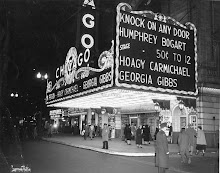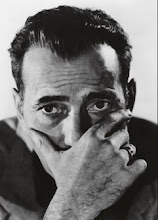The highpoint of this 1946 B-movie arrives about two thirds of the way through when a newspaper spins into focus, it's headline screaming ART CRITICS ASK POLICE PROTECTION!
Not the kind of phrase one reads everyday, or even once in a lifetime but it just about sums up the style and tone of HOUSE OF HORRORS.
New York's art critics are filling their lace embroidered panties with a warm smelly brown manifestation of uncontrollable fear on account of a serial killer known as The Creeper (Rondo Hatton). This hideously ugly monster of a man (who doesn't actually creep anywhere) is targeting these effete pen pushers at the behest of a mentally unbalanced sculptor named Marcel de Lange.
de Lange, played with hammy relish by Martin Kosleck, wants revenge on those who've savaged his work and talent in the columns of the city's newspapers, but he's too skinny and weak to do it himself. So he persuades The Creeper to do his dirty work for him by offering him friendship and a roof over his head.
There's several fascinating aspects to this storyline, chief among them the incredible and implausible importance that it places on the role of the art critic in society. In the New York of HOUSE OF HORRORS these foppish, self-professed charlatans write the most influential and widely-read columns in their respective newspapers, and wield their immense power to make and break young artists with nary a single consideration for ethics, honesty or journalistic integrity.
All that is, except one, who's neither foppish nor effete but female and incredibly annoying. The way Virginia Grey plays Joan Medford, she deserves to be The Creeper's first victim. She's a socialite with a line in fancy hats playing at being an art critic. She complains incessantly about not having a story for her Sunday column, and is endlessly bothering artists for stories she can write up but she never once produces a notepad and pen, not even when she insists de Lange recount his entire life story so she can fill that Sunday column.
Of course this being 1946 it's still a man's world (despite the millions of women who'd recently taken over men's jobs to aid the war effort) so Joan is not to be mistaken for a serious journalist. She's just playing at it, to get that tiny bit of ambition out of her system, before she succumbs to the inevitable marriage proposal from her artist boyfriend (which comes after she's helped clear him when he's falsely accused of The Creeper's murders) and retreats to the kitchen to prepare his meals and have his babies.
She's such an amateur she doesn't even realise she's found The Creeper when she finds him, and she's so not really an independent woman that she runs plumb out of ideas on how to escape The Creeper's grasp when she finds the door locked. It's clear after turning the handle twice that it's not going to open, but instead of searching for another exit she simply stands there rattling the knob over and over again as The Creeper advances on her, and it takes the deus ex machina appearance of genial Police Lieutenant Larry Brooks and his cheesy grin to save her.
Ironically it's Rondo Hatton who evokes the most sympathy despite The Creeper's penchant for snapping spines. Hatton reprises the role he'd first played 18 months earlier in the Sherlock Holmes thriller 'The Pearl of Death' and with the obvious exploitation of his deformed features (he suffered from acromegaly) for shock value it's difficult not to feel for him (although it's not known how Hatton felt about the kind of parts he was getting, so it's possible he didn't feel exploited in the slightest). The Creeper is so ugly just the sight of him paralyses his victims
making it all the more easy for him to break their back, and the film encourages us to stare at his ugliness until we feel physically repulsed, and then stare some more.
Although billed as a horror movie there's precious few genuine chills and way too much chat to be had in HOUSE OF HORRORS. There isn't even a house that fits the titular bill unless it's referring to the studio adorned with de Lange's hideous sculptures. But the film only runs 65 minutes and on that basis I recommend it as a worthwhile investment of your time.
26 June 2012
Subscribe to:
Post Comments (Atom)




No comments:
Post a Comment